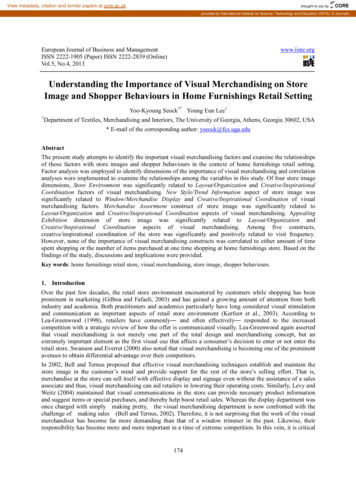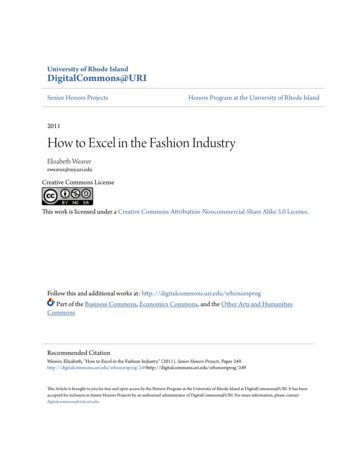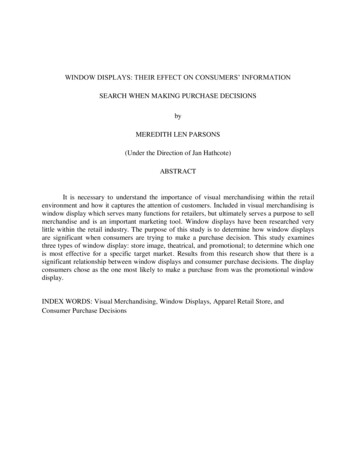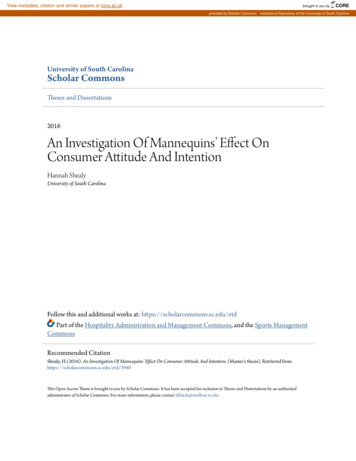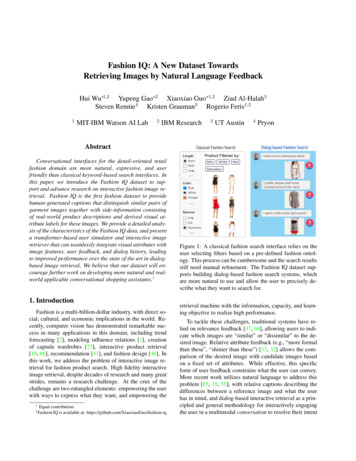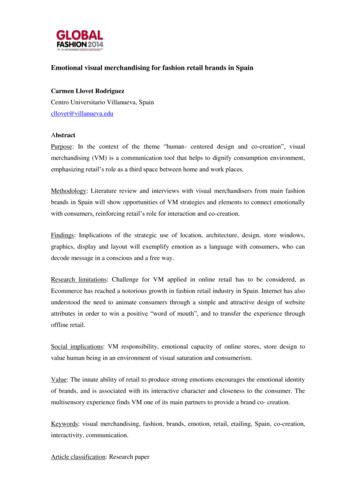
Transcription
Emotional visual merchandising for fashion retail brands in SpainCarmen Llovet RodriguezCentro Universitario Villanueva, Spaincllovet@villanueva.eduAbstractPurpose: In the context of the theme “human- centered design and co-creation”, visualmerchandising (VM) is a communication tool that helps to dignify consumption environment,emphasizing retail’s role as a third space between home and work places.Methodology: Literature review and interviews with visual merchandisers from main fashionbrands in Spain will show opportunities of VM strategies and elements to connect emotionallywith consumers, reinforcing retail’s role for interaction and co-creation.Findings: Implications of the strategic use of location, architecture, design, store windows,graphics, display and layout will exemplify emotion as a language with consumers, who candecode message in a conscious and a free way.Research limitations: Challenge for VM applied in online retail has to be considered, asEcommerce has reached a notorious growth in fashion retail industry in Spain. Internet has alsounderstood the need to animate consumers through a simple and attractive design of websiteattributes in order to win a positive “word of mouth”, and to transfer the experience throughoffline retail.Social implications: VM responsibility, emotional capacity of online stores, store design tovalue human being in an environment of visual saturation and consumerism.Value: The innate ability of retail to produce strong emotions encourages the emotional identityof brands, and is associated with its interactive character and closeness to the consumer. Themultisensory experience finds VM one of its main partners to provide a brand co- creation.Keywords: visual merchandising, fashion, brands, emotion, retail, etailing, Spain, co-creation,interactivity, communication.Article classification: Research paper
IntroductionIn late decade a new approach of the store has been reached, mainly because of several factors:visual saturation, multiple channels and audiences, new technology and strong competitiveness.The store, as a brand itself, has showed the ability for deliver emotion and a strong experienceof familiarity (Kent, 2007: 735, Collins-Dodd and Lindley, 2009). In a context where rationalityhas been substituted by desire, textile retail has to satisfy an emotional experience (Burns andNeisner, 2006).Previous research has demonstrated how store atmosphere influences on consumer attitude andbehavior (Kotler, 1973, Davies and Ward, 2003). The emotional “is very useful in fashionsector” (Brengman and Willems, 2009: 352) because emotions and experiences are linked tosuccess, not only from an academic point of view (Foxall, 1997; Sherman et al., 1997;Wakefield and Baker, 1998; and Vlachos et al., 2010) but also from the professional perspectiveof retail -as Carlos Aires, founder of consultant Marketing Jazz-.The identity of retail textile per excellence is an emotional identity. That explains the emotionalstrategy of fashion brands. The role of brands has to be related to actual consumer profile –hedonist, sensorial and changeable-. Moreover it has to be considered the innate textile retailability to communicate an emotional identity.Emotions have an important role in making decisions (Damasio, 2012), because they allowconsumer to decode fashion brands’ message. This is especially confirmed in complex andconflictive circumstances where subject cannot choose only guided by cognitive process.Spanish fashion brands have understood the power of an emotional impact in the store,particularly through visual merchandising. The design of each element is thought for interactionwith the consumer, as their visual merchandisers have confirmed.Conceptual frameworkEmotional space for an emotional consumerEmotion is defined as “internal and subjective experience by an individual of a complexbehavior of physical and mental changes in reaction to some situation” (Batey, 2008: 25).From the first part of this concept it can be identified that emotion is associated with a personalexperience of intimate and nontransferable features. This is due to invariable characteristics thatconnect with our collective subconscious, as a depot of innate and learned experiences. Emotionhas the ability to activate associate networks relevant for memory, and to establish a position ofindividual in the environment, encouraging him to some people, objects, actions or ideas (Urrea,
2011). By its personal feature it is said that emotion gives sense to experiences. It is linked withsomething that actually happened to someone and meaningful for the subject. Emotions get adifferentiation difficult to imitate due to fulfill the consumer need with a customized experience.Second part of the definition of “emotion” by Batey points out that emotion is a reaction to theimpulse that provokes the action. Reaction -sentimental or affective, cognitive or behavioralcan be aroused to a situation associated with humor, temperament, personality or motivation(Urrea, 2011). Benefits in experience are referred to sensorial pleasure or cognitive stimulation(Park et al., 1986).Immediate and subjective answers to our sensorial receptors are sensations. Interpretation andmeanings of sensorial stimuli are built with feelings and beliefs. Feelings and senses are“universal experiences deeply from the childhood in our language and thought” (Heller, 2004:17). Therefore, cultural influence prepares human being to perceive stimuli in a certain way(Batey, 2008: 51). Physiologic signs (somatic markers) and emotions evoked are associatedwith past benefits, impulse some behaviors (decision making) and avoid some others, accordingto Damasio (2012). The author proposed that “somatic markers direct attention towards moreadvantageous options, simplifying the decision process”.Some criteria determine types of emotions. The context of brand meaning will help todistinguish the type of emotion and the dynamic language that describes it. Six basic emotionsfrom classic Philosophy –love, hate, desire, happiness, sadness and admiration- can becompleted with “social emotions” learned in public context –shame and proud – (Batey, 2008)and emotions that act as mediators of consumer answer to advertising and to attitude towardsbrand –relax, happiness, satisfaction, surprise, excitement and reward- (Holbrook and Batra,1987; Dawson et al., 1990; and Yoo et al., 1998). Emotions are linked to main aspirations thatimpulse the action (García Ruiz, 2009).Emotion can be considered a language in terms of what McCracken (1988: 57) describes it:those that let the consumer the freedom to decode the message. Therefore, visual language forexample uses the influence of aesthetic based in color and light, evoking emotions andconnections with consumer in a subconscious level.The fact that consumer decisions are not based on the characteristics and advantages of aproduct, but guided by an experience, is due to consumer is attracted by the intuitive part ofbrain, according to Schmitt (2006: 46). The author asks companies “not to treat clients just asrational beings because clients desire to be attended, stimulated, emotionally influenced and
creatively provoked”. Furthermore, Morin (2011: 134) explains that individual uses just 20% ofbrain consciously. It can be assured that experience is based on emotional brain.As retail industry is highly influenced by consumer behavior, the research suggests determiningsome of his needs and desires. The interpretation of sensorial information and reaction ofconsumer from different countries depends on socio cultural rules. Cultural values influence onconsumer motivation and consequently influence on product, brands and stores.What values are predominant nowadays? Psychological research portrays a consumer profilethat seeks for customization, positive experiences, and need of attention and feeling important:more subjective values that show an emotional and psychological shopping experience (Alfaro,2011: 23, Carpenter et. al, 2005).Taking into account the influence of consumer profile on retail’ strategy and image, to answer ashopper that enjoys shopping, retail space must gather the following features: an emotionalatmosphere (Williams et al., 1985: 314), a multisensorial experience (Surchi, 2011),entertaining the consumer (Manlow and Nobbs, 2013) and provide a minimal level of functionalvalue, showed in “proper product in place, time and price” (Carpenter et al., 2005: 51). Barnesand Lea-Greenwood (2010) point out that fashion store atmosphere must be prepared to displaynew fashion product with physical and emotional elements, although those related to productare especially considered: windows, display and signs. Change in the experience is most basedin bran communication that in manufacturing.Retail’s innate ability for interaction and experienceMain aspect of emotion in retail textile is sensorial experience because it constitutes “interncondition of feeling and the aware experience of emotions” (Batey, 2008: 51). Experientialmarketing improves communication because it is client oriented. Retail space has been named“the third space ( ) as serves a more abstract social purpose: the use and design of retail spacesin the store itself and their extension into the wider shopping environment, typically the street,mall or centre ( ) as spaces for consumption, play or enjoyment, they provide an importantmedium for communication and interaction, as well as arenas for synthesizing leisure andconsumption” (Kent, 2007: 737). “Store must be linked to clients through emotions: stories thatallow consumer to find meanings as cultural values, significant communities and culturalnecessities” (Kent, 2009: 18).
If brands want to deliver confidence and openness, the communication way per excellence is adialogue face to face: the multisensory language of interpersonal communication (Pine andGilmore, 1998).Retail is the business model that best communicates the brand -defined as “distinctive imageperceived by a series of values that motivate consumer to act positively towards it” (Jackson andShaw, 2001: 183)-. This trend named “retailbranding” “is one of the most important in retailingbecause it implies consumer loyalty” (Grewal, 2004: 9).History of retail textile in Europe highlights the need for emotion in a context of “fashionconsumer’s lost of choice” characterized by factors as: international competition, retailer’s newtechnologies to know consumers, big holdings and low prices, adaptation to informal lifestyles,socioeconomic change that impulse women and children as main characters of shoppingdecisions, new transparency of international price, value retailers pressure –new product at lowprice- and etailers- (Jackson and Shaw, 2001: 156).To the goal of sales -through goods displayed between 1960 and 1990-, it has been added thetriple role of the store: to get information, to give information and to deliver brand image. Thetransformation of the point of sale is due to the innate ability of retail to answer three changes ofthe environment: multiple channels and audiences, new technology and strong competitiveness.It does it through customized information, experience managerial, interactive character andcloseness to consumer.Regarding to the change observed in the environment about multiple canals and audiences, therole of retail in communicating the brand has been revitalized (Surchi, 2011). New ways ofshopping and social networks have changed the way consumers process the communications(Keller, 2009: 139). Sádaba points out how “our lives have been deeply affected by newtechnology of human communication”, and specifically how persuasion is affected. The authorexplains how Internet adapts traditional features of dialogue to adjust to its definition as “freeinterchange of experiences through which human being discovers by himself the cause of whatsurrounds him, the pleasure of reason and the knowledge of the world and the others (Sádaba2005: 275).Retail social ability answers to the search of more personal communications, against themistrust and lack of clarity in advertising messages. Customization as a consumer demand is afashion concept, as Sádaba suggests (2005: 274), regarding to the extended literature reviewwritten about it lately.
Interaction in direct contact between brand and consumer through the store delivers theinformation that the individual wants and the way he wants: brand experience. It is defines bythe consumer ability to constitute his own ideas and emotions about the product and the brand.The author stands out that, beyond commercial goal, the activity that communicates associationsbetween brand and consumer created by a shared experience, implies a value proposal and looksfor influence on attitude and knowledge of target. It means an affective agreement with thestore, defined as “the desire of maintain a relation that client perceives as valuable” (Sasinandiniand Manohar, 2010: 35), and consequently, it generates loyalty (Bloemer and Ruyter, 1998;Collins- Dodd and Lindley, 2003).There are some requirements to increase brand value trough brand experience. Firstly, toimplicate client in the whole process, because people learns more form the implication thanfrom the passive observation (Aaker and Joachimsthaler, 2001: 298). Concerning to this, Seguraand Sabaté (during a conference in 2008) points out that positive perception of consumer inevery contact with the brand will turn him into a brand ambassador. Ballantyne confirms in aninterview that experience comes from listen to the client, without forgetting to connect with himthrough five senses. “An experience that stimulates the five sense -sight, ear, smell, taste andtouch- is the most memorable” (Aaker and Joachimsthaler, 2001: 298).Secondly, another requirement of brand experience is that message about the organization andits products connect with brand, according to Ballantyne. Multiple contact points that composethe experience reinforce emotional position of the brand. The creation of environments to buildexperiences has implied a key for the change of retail sector in Europe: has meant “a catalyst ofgrowth in mature Economies of low increase of consumer spent” (Dawson and FrasquetDeltoro, 2006: 20 and 21).In United States an example of success that turned the brand into the best retailer of America isApple. Useem published in Fortune in 2007 that when Apple hired the ex executive of Gap,decide to design stores as products: around what can be one with them. However it was notenough and the company redesign its stores to offer a hotel service experience, because for 16among 18 people interviewed, “the best experience was from those who help but don’t sellanything”. The company create a space as a club and interactive, with a bar where supplyadvices, an area for photographs or videos and another area for problems. As a result, Appleraised its sales more than Saks or Tiffany, increased the number of visits and improved theimage among first ten companies of Fortune.
The way retail has adapted the second change in the environment, especially interactivity ofgames (Kent, 2003), is its ability to get and give information. This is due to retail position insupply chain, allow it to identify, interpret and satisfy consumer needs.Retail, as a type of business closer to the client than to the provider, turns the store into “a toolof the communication strategy that wins a personality like human personality” (Kent, 2003). Italso generates a good manage of client experience (Birtwistle et al., 1999b). The fact thatretailer communicates in a personal way with the consumer at the store, where decision makingtakes place as a result of the interaction, the retailer can influence on brand value (Ilonen et al.,2011: 414).Pine and Gilmore (1998: 99) affirms that interactivity of new technologies (through chats,Internet, simulators or virtual reality) is based on real life. At the same time physical store isinfluenced by Internet to look for a nearer link with the consumer and adopt new technologies.New online stores have extended interactivity of virtual space characterized by immediacy,symmetry and active, personal and direct role in a new conversation where consumerpreferences are considered.Examples of this are the virtual changing room of Pull and Bear, the tablets to buy Mango’sproduct not available at the store, or the interactive windows of Nike that allows consumer tobuy through devices without entering the store. Another example according to George Homer in an interview- is Vittorio and Luchino’s store at Madrid that creates a consumer profilethrough a program accessed by dial telephone number.Regarding the store as a point of sale that gets information, Interbrand’s report (Best Spanishbrands, 2011: 3 and 48) highlights its role of brand manager because “predict and answerconsumer desires and expectations”. For instance, the recruit of personal data allowscustomizing offers and establishes a special relation with clients, improving the shopping area.Birtwistle et al., (1999a) point out that the success or failure of a store depends on retailerability of understand consumer perceptions about store image. Martínez Barreiro (2007: 71)explains the organizational process of Zara that allows the retail brand to “stimulate to sharedata in order to access easily to the system in real time”. The Spanish company is a paradigm ofthe store as “the main channel of getting information about products, shopping environmentdemanded by consumers and the marketplace” (López and Fan, 2009: 281).
The information between the store and central services is delivered through the followingchannels: till, products sold and warehouse daily); telephone, fax and mail; PDA Casiopeasoftware system for Inditex; and visits of executive from central departments that allow tophotograph forms and ask for orders to logistic center (Martínez Barreiro, 2007: 78).According to Adolfo González, Creative Chief of digital agency of marketing andcommunication WYSIWYG (“What you see is what you get”), “the point of sale is the mostinteractive channel because of the face to face relation with the consumer” (Estrategiasmagazine in 2006). In store, the interactivity is showed in the use of interactive technologies orin the animation. Living windows are joined, consisting in the use of living mannequins or theuse of windows as a benchmark. Out of the store the interactivity of architecture promotes thename of the brand as if it were a tridimensional advertising. The company made illustrations forSpringfield website.Retail is considered the ideal space to show the promise of the brand, according to Report BestSpanish brands (Interbrand, 2011). Main feature associated with fashion brands is emotionalfeature (Brengman and Willems, 2009: 535). This is due to the influence that design and storeimage have on a type of consumer. And it is reinforced in a historic moment where it is essentialto provide “spectacular, experience, technology, high quality, brand image and personality”(Kozinets et al., 2002: 24).Visual merchandising, mediator of emotionsThe role of affects in evaluation of retail stores has been widely recognized in literature review(Mehrabian and Russell, 1974; Donovan et al., 1994; Fiore et al., 2000; Gilboa and Rafaeli,2003; Workman and Caldwell, 2007; and Cohen et al., 2008). Store image as “a combination ofemotions and knowledge coming from store perceptions” (Porter and Claycomb, 1997: 14), iskey in shopping choice and retailer success. Burns and Neisner (2006) associate an emotionalrole especially to the store image psychological features, based on consumer affectiveperceptions, not consciously controlled.Fiore et al. (2000) consider that if entertainment at the store improves shopping, is due tosensorial and cognitive experience influence on consumer. Although it’s true that retailenvironment is not an isolated factor; thus, for instance the increasing production and purchaseof fast fashion also has contributed to the expense. Some studies have already linked storeperception, in particular store attributes, with shopping attitudes and shopping behavior, throughthe mediation of consumer positive or negative emotions felt in the store. Marsha Richins isquoted by Schmitt (1999:131) as the researcher that best has developed the measurement of
emotions experienced in different consumer situations, included clothes consumption, becauseof the reliability of the scale. Sherman et al. (1997) study the role of retail environment asmediator of consumer emotions.On one hand, Gilboa and Rafaeli (2003) asses the parameters of pleasure, arouse and behaviortendencies that cause aesthetic elements of food retail. In particular, they value the relationbetween order and pleasure or arouse. On the other hand Zimmer and Golden (1988: 287) assurethat in the process by which consumers assess the store image, affective play a key role.Literature assure that affection participate in the creation of image and memory, depending onthe type of relation that exist between image and affect. “The nature of product offered in retaildetermines the consumer attitude towards the store (Yoo et al., 1998: 261). In particular intextile retail, VM, first in windows and afterwards inside the store, provided the opportunity ofapplying creativity and lifestyle to retail, becoming an interaction and communication way, infront of the functional goal of some sectors (Ilonen et al., 2011). The elements used are visuallyattractive shopping environments, product display and sensorial layout, according to Kent(2007).This author points out that the store as an spectacle and a theater creates the of being partof a something bigger, remembering the consumer his participation in a brand community.Yoo et al. (1998) identify the emotional characteristics of retail experience. Authors add thatemotions are socially oriented by social benefits of retail environment. They verify that whilemost of attributes – variety and product value, ambience, guarantee period- affect emotions, andemotions affect shopping attitude (referring to attributes affect indirectly to shopping attitudes),in the attribute “location” emotions don’t play a mediator role, and that explains that locationaffect directly to shopping attitude. Some other conclusions are also interesting. For instance,some elements only provoke positive emotions. And “store atmosphere don’t provoke emotionswhen stores do not have perceptible atmosphere” (Yoo et al., 1998: 261).To understand emotional brand value, emotions can be measured associated with brands byconsumers, according to Birtwistle and Shearer (2001), Ahuvia (2005) and Maehle et al. (2011).A way of measure them would be through focus group among different target –age, sex-.Consumers would be asked to define emotion reflected and to assign emotional features tochosen brands in a free way. For instance some authors study what brand personality isattributed by consumer, how perception is constituted and its differentiation from other brands.In Spanish literature a similar research has been carried out by Rodriguez Arenas (2003) todetermine emotions and experiences that consumers from Chile had about twenty brands among
Retail Ranking of brands in shopping centers. Focused on those brands that are expected to sellclothes adjust to trends, there are results about Zara and Mango. The author made surveys tofind the retail brands positioning. In a first stage of pretest, the author asked 112 people (18-49years old average) about associations with store image: personality of the store attributed whenthinking about the store and emotions felt at the last visit of the store. At final survey consumeris required to assess in Likert scale a series of emotions felt when visiting the store. Among theconclusions, Zara is one of the best perceived brands because it is remembered as “unique” and“introverted”. And Mango is one of the most associated with “appearance”, “quality” and“closeness”.Other proposals to assess emotions are participating observation in the store (as Barnes and LeaGreenwood, 2010) and surveys to clients at the offline store or online buyers form the companydatabase. A quantitative approach would allow finding the combination of lasting featuresassessed by test of personality. Authors like Groeppel-Klein (2005) propose the measurement ofemotions from systems that collect more than what consumers say about VM. It would bethrough an electronic system linked to consumer movement at the store. And they conclude thatthe store named “experimental” delivers more happiness than the store named “controlled”.If emotions are strong mediators in the process by which consumers receive messages, takinginto account the difficulty of traditional research methods about register subconsciouscomponents as feelings (Morin, 2011: 134) and the saturation of 10.000 messages, neurosciencehas been the best way of know clients and optimize our brain.Alfaro (2011: 24) explains that emotional link implies for brands to get faster decisions to itsclients, who cannot explain rationally the cause that motivated them to purchase. Nowadays70% of shopping decisions are taken with emotional brain and 3.000 times faster than rationalelements (Alfaro 2010: 45).To observe and understand shopping behavior of fashion consumer form the brain perspective isthe value of neuromarketing. Neuroscience is connected to psychology and economy to studyhow the brain is affected by marketing strategies. Morin (2011) assign the academic origin toprofessor Read Montagne, who affirms that different parts of our brain are activated dependingon awareness of the brand bought.Madan (2010: 34) describes the discipline of neuromarketing, defined as “the use of neuroimageand neuroscience techniques applied to a behavior process to reach a commercial goal”. On one
hand, the author highlights the ability to measure consumer answer through a more scientificmethod, going in depth in its attention, emotional condition and feelings such as trust.For instance, neuromarketing would allow designing a kind of advertising that lead theconsumer to some product preferences. This kind of research acquires a special value in periodsof high pressure to assess the return on investment in advertising (Morin, 2011: 133). Madanalso emphasize the social value of this science, due to its ability for detecting clinic disorders ascompulsive consumption.Kyriaki (2012) also suggest that neuromarketing could understand better human behavior andsolve a problem. Guessing what the consumer needs and giving him the perfect product thatappeals to the ideal that want to get when buys a symbol, it will contribute to complete him. Forthe author, psychology and emotions play a key role in decisions when products are bought bywhat the mean, because “the nature is constituted from social and cultural impacts” (Kyriaki,2012: 21).Ariely and Berns (2010) also support this research. Firstly, because it makes easier the decisionconsumer due to knowing a kind of information (the emotional, kept in subconscious (Fugate,2007) not available by other methods (because the consumer do not know how to give opinionwhen required to do it in a explicit way). Secondly, to use a method is cheaper, faster andprevious to any campaign (even of VM), which also would save money.On the other hand, Madan (2010) and Murphy et al. (2008) do not hide the critics of a methodethically controversial. Both researches propose ethic codes that control consciousness andprivacy of participants, and consumer autonomy protection, especially of vulnerable consumer,for instance children and people affected by psychological disorders (to be manipulated in termsof make the shopping impossible to resist, but also in terms of create anxiety, fear or distrust).The authors argue that this new science of consumer behavior permits to improve marketingefficiency without request cognitive or conscious participation of consumer (Morin, 2011: 131)to obtain commercial. To end the controversy, Fisher et al. (2010) explain that this research areais valid to understand science, although it implies the risks of attempting to individual autonomyand social damage –as provoke consumption or something negative for the consumer-.Interviews to visual merchandisers of fashion brands in SpainOnce literature review is completed, interviews with visual merchandisers from main fashionbrands in Spain show opportunities of VM strategies and elements to connect emotionally withconsumers. These are the professionals interviewed in 2011:
Alberto Criado, Director of Visual Merchandising at Zara. Richard Gum, Director of Sales at Cortefiel Man (Cortefiel) who was before Directorof Visual Merchandising Department and Manager of Cortefiel for Portugal. Juan Manuel Gil, Director of Visual Merchandising at Hoss Intropia and was beforeDirector of VM in Cortefiel. Gil worked with Gum in Cortefiel, and formed WindowsDepartment for Marks & Spencer and Trucco. Iván García, Director of Visual Merchandising at Las Rozas Village (Value Retail).García took part of VM Department in Zara, Urban Outfitters and Selfridges (London)before.The quotes of the interviewed are chosen from the approach where VM consists in the “display,coordination, attractive exposure that makes easier the relation between buyer and shopper”(Bou, 2008: 10) or VM is considered “everything that makes change or settle shoppingorientation because makes closer that product to the client in the best possible conditions”(Macías Rodriguez, 1972: 16-17).Taking into account the description of emotion and specially its link with senses, from theinterviews there has been selected some visual merchandising elements that makes easier theshopping and provokes interaction or value co-creation: Architecture, facade and location- Zara first positioning is through the spect
particularly through visual merchandising. The design of each element is thought for interaction with the consumer, as their visual merchandisers have confirmed. Conceptual framework Emotional space for an emotional consumer Emotion is defined as "internal and subjective experience by an individual of a complex

